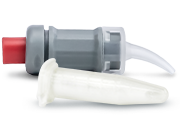
Whether you are a dentist purchasing/opening a new dental office or an office manager running a busy practice, the pediatric dental team is the lifeblood of a pediatric dental office. Pediatric dentistry is unique as there are often two individuals that play an integral role in the child’s dental health; a caregiver and the child. Managing both individuals and keeping them happy is not possible without a team effort. Creating a great pediatric dental team starts with a vision.
Vision Statement
Creating a mission statement or a vision for the office is important. Without goals or something to work towards, a team cannot stay motivated to move forward to accomplish new tasks. Teams are more likely to succeed if they have a purpose or mission.
“A shared vision is not an idea. It is not even an important idea such as freedom. It is, rather, a force in people’s hearts, a force of impressive power. It may be inspired by an idea, but once it goes further—if it is compelling enough to acquire the support of more than one person—then it is no longer an abstraction. It is palpable. People begin to see it as if it exists. Few, if any, forces in human affairs are as powerful as shared vision.”
― Peter M. Senge,
Creating a vision may sound intimidating, but it is essential to the ongoing development of any business—whether it is dental related or not. Some questions that one may find helpful when creating a shared vision are:
- What is the mission or purpose of the office?
- Who are we?
- What are we here for?
- What are we doing?
- Why is what we are doing important?
- Are we here to make a difference in the lives of the people we are serving?
- What is the difference we want to make?
Answering these questions can be a great start to creating a vision, but the office should go further and consider core values.
Creating Values for the Dental Office
A mission or vision statement that is based on the values of the dental team. Having a mission statement and set of values can make it easier for a dental team to make decisions on services and treatments that are offered as well as protocols for the office. When making key decisions, referencing the mission statement and values can improve the decision-making process. If treatments and protocols align with the vision and values of the office, it may be easier to implement positive changes. If new ideas do not align, these values can serve a greater purpose to prevent negative changes.
The pediatric dental team can be a part of defining values of the office through these simple exercises:
- Ask everyone to individually write values that are imperative to them that they would like to.
- Break the team into pairs, and have the team cross out words that aren’t the same (it doesn’t mean that all the words aren’t great!).
- Continue to the next pair of individuals.
- You will likely end up with 2-4 values that are the most imperative to the pediatric dental team.
Hiring an Ideal Dental Team Member
Developing a mission statement and shared vision can make it easier to hire the right person. Incorporating the office values into the ads for the position can help attract the right person. Once a person responds to the ad, have the person send a cover letter and a resume. Building a resume can be very simple, so requiring a cover letter can make sure the person is proficient in writing and determine their intent for applying for the position. Once the top candidates are identified, it may be best to conduct a phone interview with two or three questions. This will help the office see which candidates perform well and allow you to evaluate their “telephone voice.”
Top candidates then can be invited into the office for an initial interview. It is important to pay attention to how they present themselves and handle questions. As a general rule, 30% of the conversations should be on behalf of the office and 70% of the conversation should be the interviewee talking. A state-approved application can be given to assess the skills of the prospect to write and think on their feet.
A second interview can be given to the top two or three candidates. At this time, it is appropriate to discuss expectations of the job, salary, benefits, and any other specific details about the position. Some practices may elect to have the team spend some time with the candidate; make sure the office reviews what can and cannot be asked.
Once a decision has been made, it is best to send a professional letter to all candidates. Sometimes the first candidate does not work out, as they may have taken another position prior to the offer.
On-Boarding a Pediatric Dental Team
Once a person is hired, there should be a systematic training process. Define the position and job description and the order of skills that will be taught. This can be then put into a timeline to allow for specific training tasks to be completed. New hires should be given a mentor who can demonstrate the necessary tasks for the position and be checked on sporadically after they have completed training on a task. The mentor can also check in with the individual at the end of each day or the end of each week. This can help the new hire be more productive and receive positive feedback.
“The greatest management principle in the world is that which is rewarded is repeated.”
― Cathy Jameson
The Greatest Management Principle in the World, Micheael LeBoeuf, PhD
Moving the Pediatric Dental Team Forward
Team meetings are needed to keep the practice moving forward. There is no perfect day in a pediatric dental office. Team meetings can be done by having a daily huddle and weekly or biweekly meetings. This can be time to discuss the day and provide staff information on opportunities as well as challenges. Knowing when a child’s behavior may be more challenging, and they might need some extra time, can help avoid scheduling emergency patients at the same time. This can result in better patient experience and lower staff-member stress. Having weekly meetings are beneficial to share the pulse of the practice and integrate feedback and changes to improve the office moving forward. Weekly or biweekly meetings should have an agenda with results and expectations.
- Have a starting and stopping time. Don’t go over time.
- Organize the meeting. Set an agenda.
- Review critical factors of dentistry (ie production, collections).
- Identify systems that may need improvement.
- Set timelines and deadlines.
- Assign tasks to individuals, and evaluate their performance.
- Follow up; don’t have a meeting where nothing happens!


